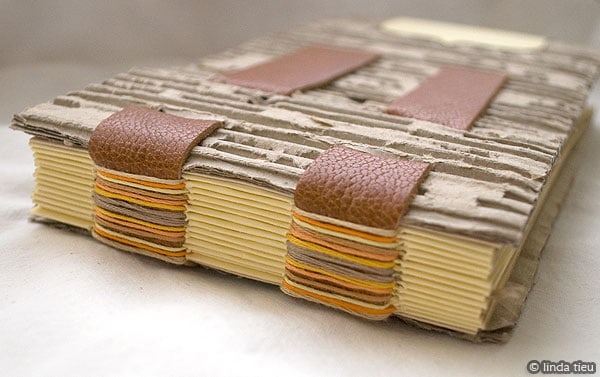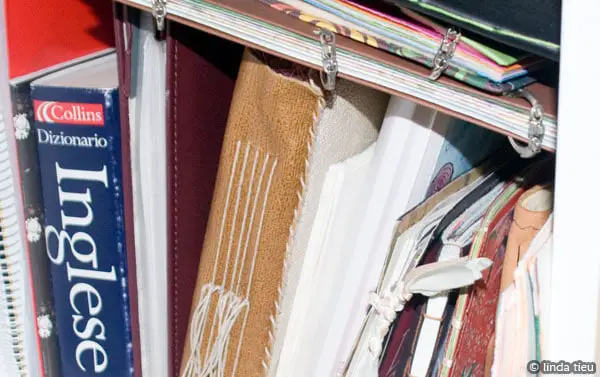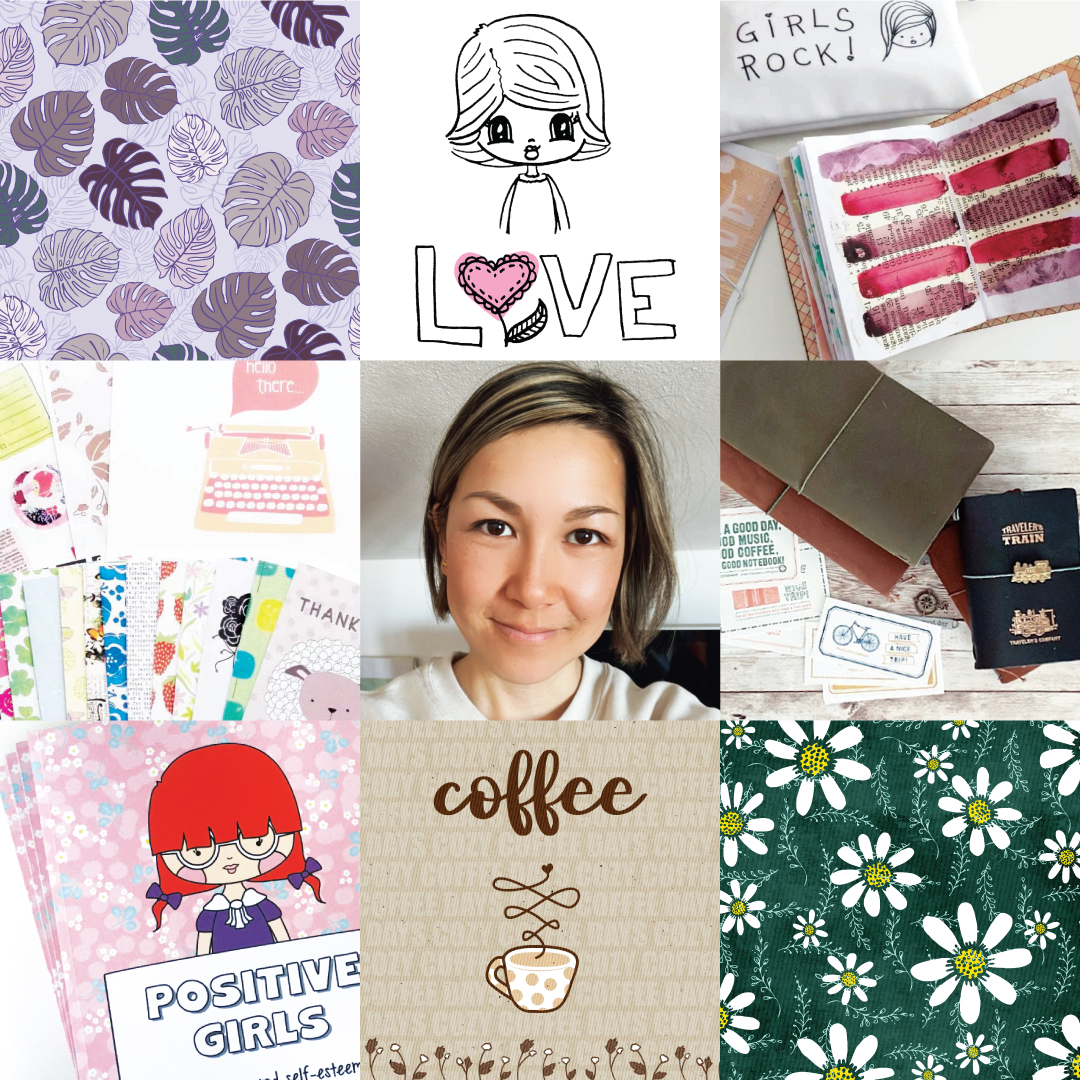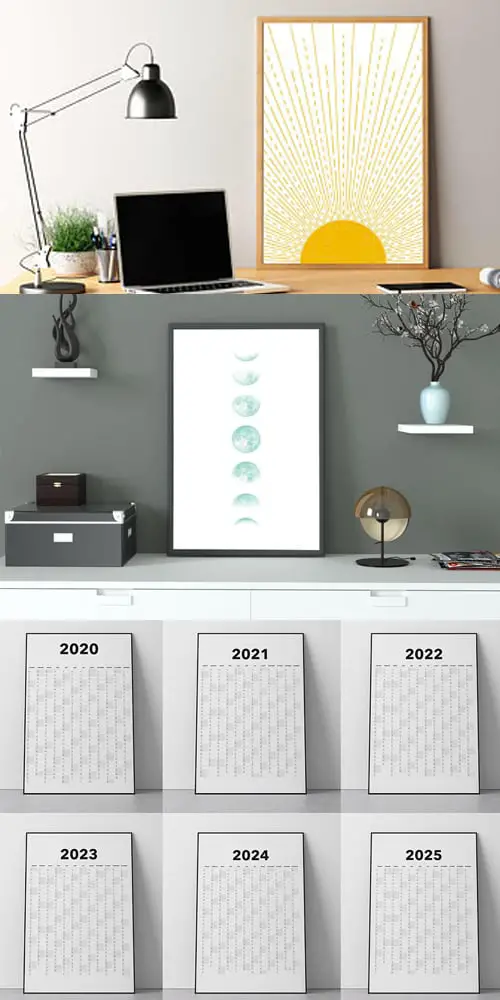by Linda | Sep 19, 2012 | my creative journal
I’ve blogged about my bookbinding tools and materials, but thought it would be helpful to start a series of posts that goes through my thought process of creating a brand new handmade journal from scratch. Inspiration can certainly come from many different sources. Sometimes an embellishment might seem really cool to add to a journal cover and that’s where it all begins. Or perhaps a new binding stitch discovered tempts me to try it out. Or even coming across some special drawing paper that I want to test.
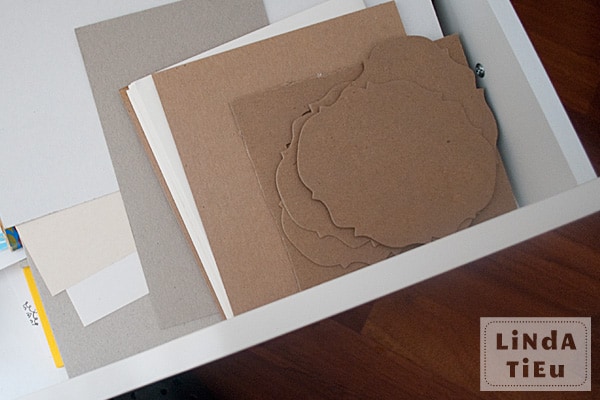
But most often I’m inspired by cover materials… what will my journal look like outside at first glance? What will protect my precious journal entries from the elements? What look, feel, style will set the theme for the whole journal? Since we see the covers of our journals pretty much every single time we use them, I would say it’s a pretty important aspect. It’s also just fun to experiment with all kinds of different materials.
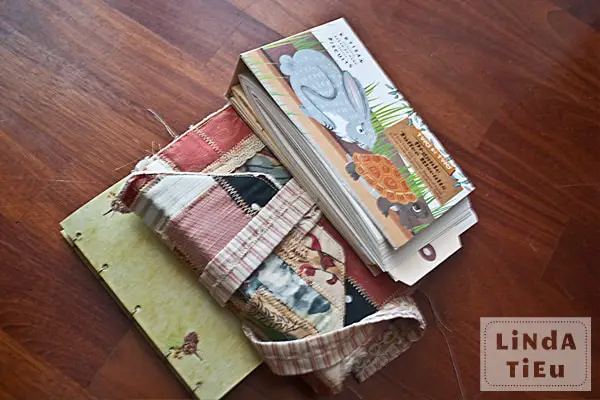
Let me say that you can literally use any material for your journal. Yes, any material, I said. Even when something seems flimsy or difficult to work with, remember that you can always mount it on another base material and protect it with a layer of varnish or gloss. Get creative! I’ve used cardboard, scrapbook papers, packaging materials, cloth, felt, handmade papers, wallpaper, paper-mache, fused plastic bags… the list goes on. Do you have a funky material used story to share?
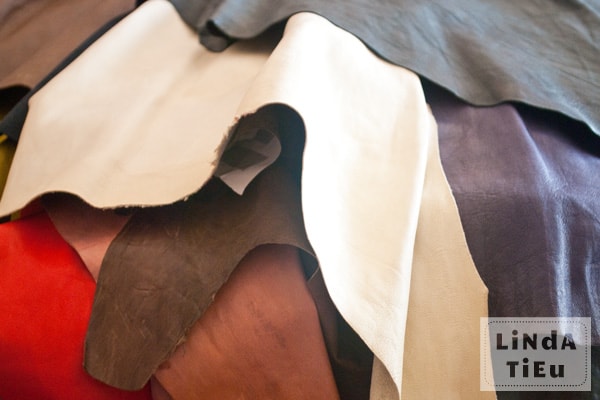
Of course, by far the most popular material for me to use is leather. This is simply because I have access to beautiful leathers (thank you hubby). However, I also sometimes back it onto cardboard or hardboard to give it more structure. Other times I also line the inside with felt or fabric to give it a lining. Here are some points to go through when considering a material for your journal cover…
- Does the material have the desired structure/weight/flexibility?
- Will you need to back it with a supporting material?
- Are you able to cut it to size and work with it to construct your cover?
- Will you need a lining material for the inside?
- How will the material stand up to the elements? Water? Fire? Tossed around in your purse?
- Will you need to consider protecting the material with varnish, medium, transparent cover material?
Hope that my tips will help you to find lovely cover materials for your own handmade journal. BTW, iHanna recently blogged about deciding on cover papers for her handmade journals as well. There are certainly so many possibilities, it might seem like too much choice. But the freedom to use what you want and use what you have, makes bookbinding fun and approachable for all. When you make your own journal that’s the first step of your creative self-expression… so try it out!
Are there other materials you have used for journal covers? Please share below your tips and suggestions.
by Linda | Dec 6, 2011 | my creative journal, Uncategorized
Over time I have learned what my favorite tools and materials are for this lovely art called bookbinding. I thought it would be nice to go through what I normally use when binding books and journal. Nothing really fancy here…I think we might all have these items in one form or another. I’m definitely a very DIY small-time bookbinder…
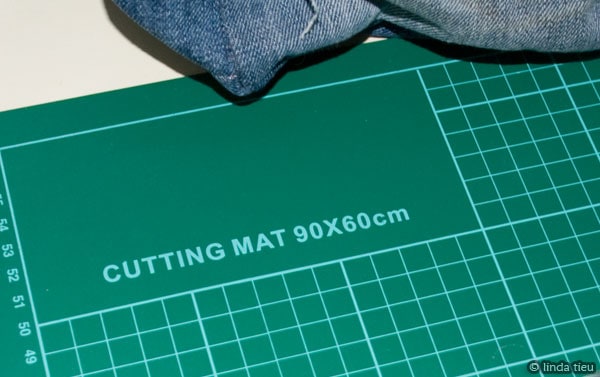
A self-healing cutting mat and cutting knives – definitely must haves in so many ways. I’ve never found a paper trimmer that I love and much prefer a mat and knife. Also, the measurements on the mat itself are very useful for lining up cuts and projects while crafting in general.
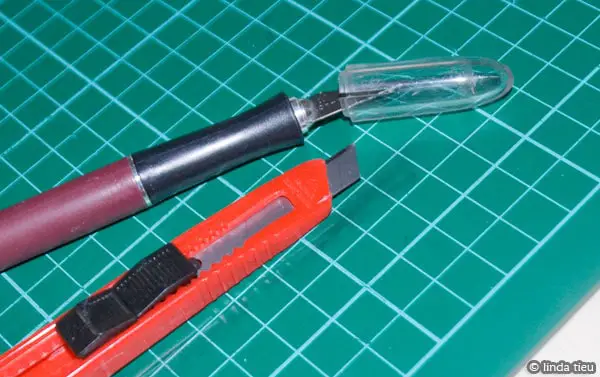
A metal ruler – metal means it will last longer and sits heavier on top of paper to prevent sliding while you cut. Love it!
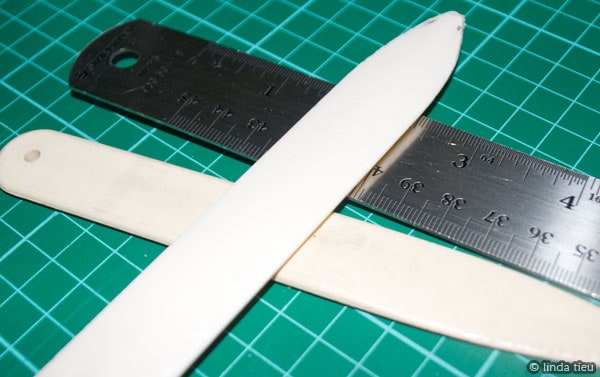
Bone folder – a must for folding paper and smoothing things over. You can also use the tip to score lines in your paper as well…
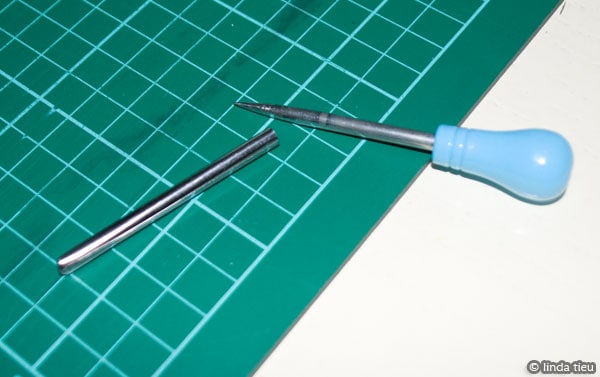
Awl – for punching holes! I have a pretty small one that sometimes gives me a handache…one of these days I might invest in the Japanese screw hole punches… very cool. Just know that you need a way to pre-punch your holes.

Needles – big tapestry needles work great for sewing up books.

Linen thread – I use both waxed and unwaxed linen thread, because it’s super strong!
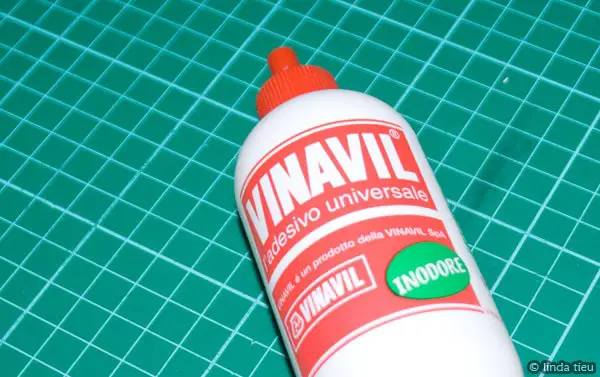
PVA glue – Vinavil is the brand we use here in Italy and it’s the same glue even bookbinding teachers at workshops use…so I’m cool with it! Really, just any glue will do.

Junky brushes – to brush on the glue – probably more important than the glue, because if you get a nice coat on, it’ll stick! I use hardware store brushes. If it gets junked up, I just toss them out.


Materials from paper to leather – I use all types of materials, even recycled board to create book covers and fill in the pages of my journals. It’s fun to use alternative materials actually.

Those are pretty much all the tools and materials that I use, so it’s nothing too fancy. Of course there are many other professional tools you can buy, but you certainly don’t need them to make yourself a journal to use!
Hope my list can help you get started in bookbinding and you might also like these bookbinding tutorials I’ve written:
by Linda | Aug 16, 2010 | my creative journal
The coptic stitch bookbinding method is another way to bind your book with a spine that opens up completely, so you can lay your book flat.
Sometimes it’s also called chain stitch in bookbinding, but more often it’s called coptic stitch binding. I think it’s a great method for when you have book covers that are individual boards instead of completely wrapped around the entire journal spine area.
With coptic stitch you will bind all the signatures and covers together with one long thread and a connected stitch that holds everything together tightly, but still with a lot of flexibility.
The pages of your book will open up completely flat and that’s a big reason why this method is so popular. You might have seen these types of hand-bound journals around, because of the exposed stitching in the spine area. It looks pretty cool and although there are variations (as with everything) – this is my method of doing the coptic stitch with just one needle.
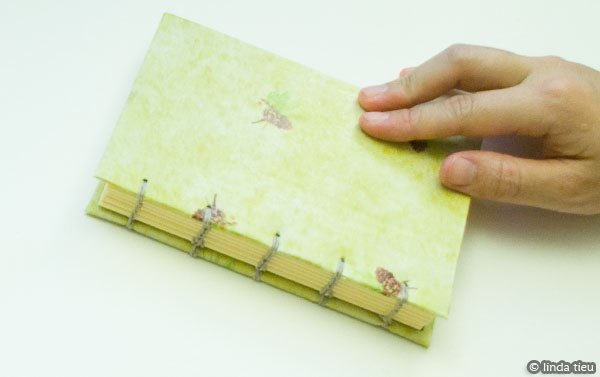
Bookbinding Materials Needed:
From a materials standpoint, your book is made up of the cover material, paper inside and the thread that holds it all together.
The tools you’ll need include a needle to sew your book together and an awl or something to help you punch holes.
For this particular journal, I’m using a roll of self-adhesive paper to cover regular cardboard for the covers.
The paper inside is plain cream colored printer paper and I’ll be using a curved needle with linen string. I also have an awl and holepuncher to make holes.
You can easily find coptic stitch bookbinding materials in your craft store or order them online. Here are links to the tools I have and they are pretty affordable – all available on Amazon. You can even buy a whole kit to start off with, giving you everything you need for bookbinding.
Please note there are affiliate links in this article that give me a slight commission if you click through and purchase at no extra cost to you. Thanks for supporting this blog!
Materials I use from Amazon:
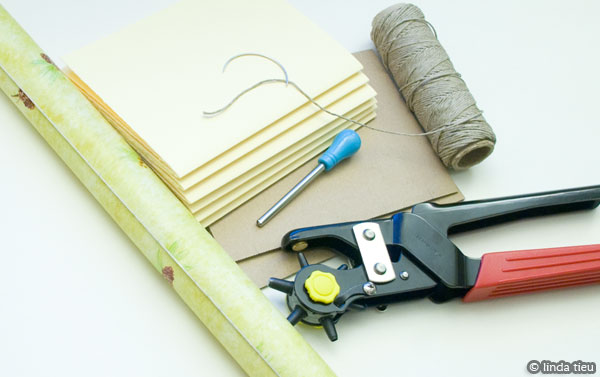
Preparation:
Before you jump into sewing your book together, make sure you have all the materials and separate pieces prepared. The more accurately you prepare all the separate pieces, the easier it will be to complete the coptic stitch without too much frustration!
First, prepare your book covers. Usually you want a thicker material to protect the pages of your book, hence the use of cardboard or hardboard or bookboard. You can then cover the boards with fabric, leather, decorative papers. In the bookbinding world, you can also use bookcloth to cover the board, which is a flexible fabric material that you can glue over your covers.
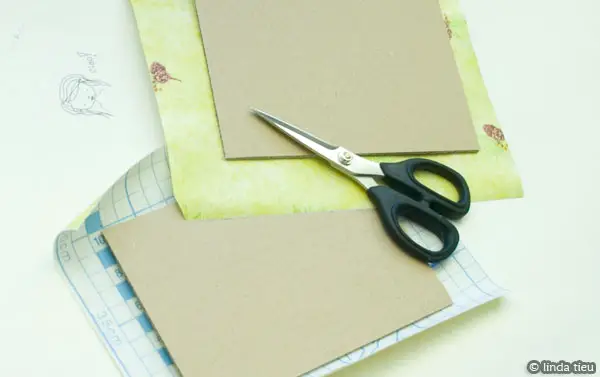
In my journal, I’m just using regular cardboard (which isn’t the strongest because it bends easily, so keep that in mind). Then I’m using a decorative paper that already has adhesive to cover the boards.
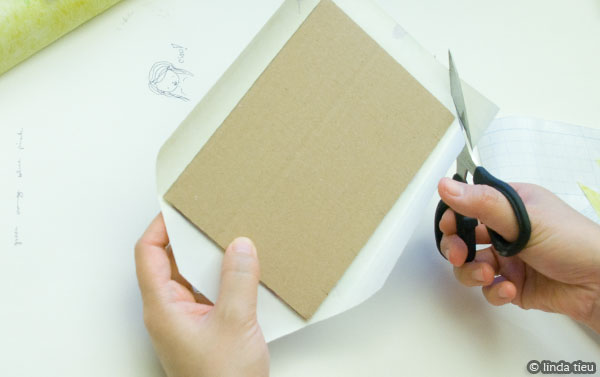
It’s a straightforward process of cutting the paper to size, gluing it to one side of the board. Trimming the excess corners and then folding over the edges and gluing them down.
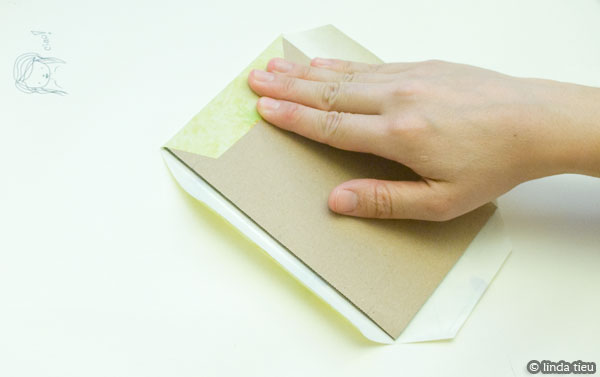
Finally, for the inside of the covers, I decided to use a dark brown paper as lining – to cover that final raw cardboard that shows. I find that it’s nice to add some kind of contrasting color for the lining of your covers, gives it a pop of color and something unexpected when you open your book.
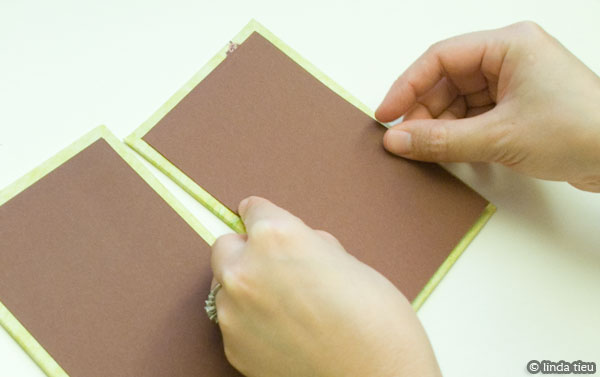
And with that I have prepared my covers for my book. However you would like to decorate your covers, make sure they are ready to go!
Then it’s a matter of choosing the paper you want inside your book and folding the papers to create your paper signatures. It’s up to you to decide how many pages you want and how many signatures you want (a signature is a bookbinding term for a stack of folded paper).
Now that my cover and paper signatures are ready, I punch all my holes to get them ready for binding.
Depending on the size of your book, it’s like creating pillars or foundations that are holding your book together. So just decide on the number of holes that will hold everything together without pages moving about.
Also, sometimes people choose more or less holes depending on how they want the spine to look. Because the coptic stitch is seen in the binding, it’s a cool design that you want to showcase. That’s also why you sometimes seem holes that are not evenly spaced, because someone chose to do that on purpose to create a cool design.
Just make sure you punch your holes in the same place for both covers and all your pages through the middle of the signatures. The key factor is to make sure they line up, so when you sew your book, it’s easy peasy and things don’t slide around.
It helps to mark your holes or create a template to mark all your holes on the cover and signatures, so you don’t make mistake.
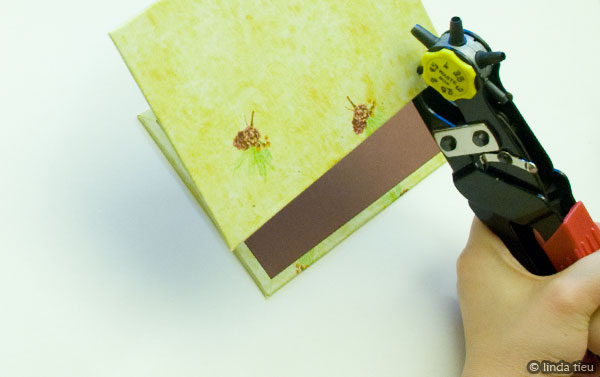
For the cover, I punch the holes using a heavy duty leather puncher. For the paper signatures, I punch holes in the center of the folded papers with my awl – using my guide to make sure everything is the same.
Remember that your holes don’t have to be gigantic when you punch them – just enough to get your needle and thread through. Obviously the larger you punch the holes the more you are weakening the paper… so just be careful!
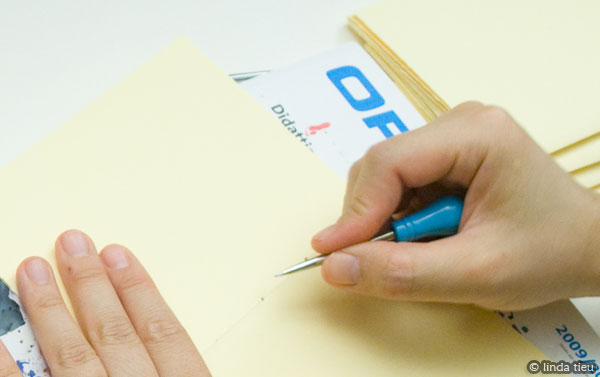
Once all your materials are prepared, then you are ready to sew your book together using the coptic stitch method. It’s a pretty easy and straightforward process that is not difficult, it’s just learning a new pattern of stitching.
Also remember that you can have as many signatures as you would like in your book. Sometimes you see pretty huge and tall spines and the flexibility of this stitch makes it very movable and snake-like. I think it looks cool, but it might not be the most handy if you are wanting something practical to use. So keep that in mind!
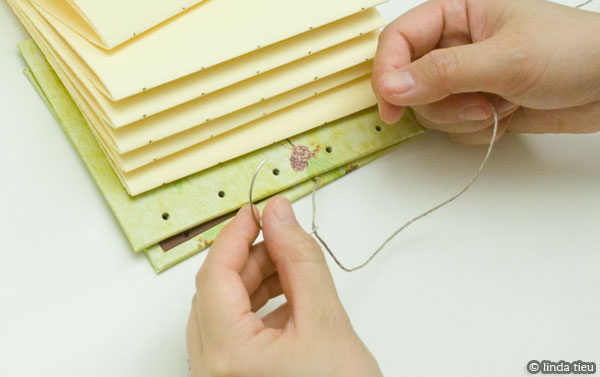
Coptic Stitch Tutorial:
To start your coptic stitch, cut your thread in one long piece and string it through your needle to get ready to sew. Now it’s sometimes hard to estimate how much thread you will need. But you don’t want to run out, because tying knots half-way just makes it a harder process and weaker binding. But if your string is too long, you might get into trouble getting everything tangled up in knots as you work with it (hence why people like to use waxed thread that doesn’t get tangled).
One way to think about how much thread you need is definitely to measure out the whole length of your book and however signatures you have, because for sure you will have to sew up and down all the signatures of paper. Which coptic you are creating knots as well, so it’ll take up a bit more thread as well! There are some calculators out there but it makes my head hurt, so I just add more thread and keep things as neat as possible so the thread doesn’t get caught! As you make more books you’ll come up with your own way to measure out how much thread!
To start my coptic stitch, let me explain and show you in photos what I am doing. First, I put my cover down and the first signature to attache to it. I’m opening up my paper signature and starting with the bottom hole inside.
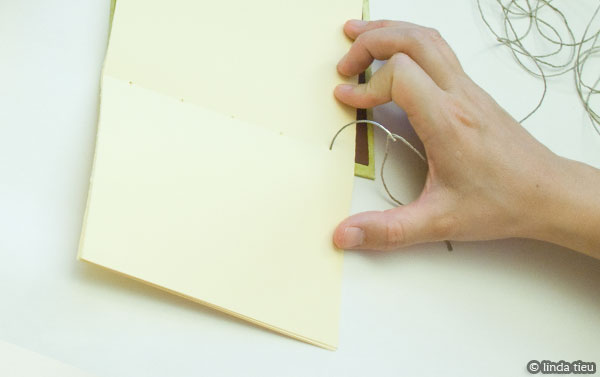
Bring the thread out and under the cover board to attach it to the signature…
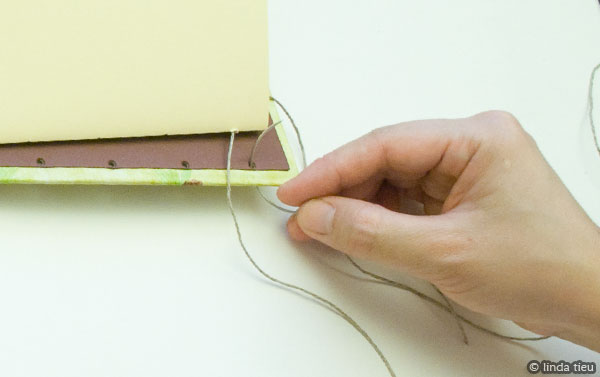
I like to wrap my thread around the cover board one more time, so it’s a double loop before putting my needle back into the signature bottom hole where I came from. This is just my personal preference. It depends how large your holes are, how delicate your paper is and how thick your thread is… so try it out in the future if you want to vary up your stitch designs.
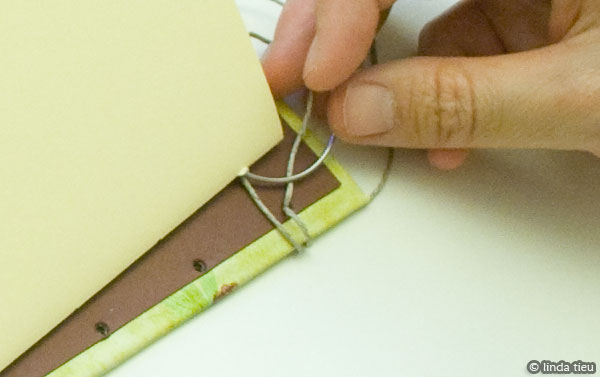
I make sure everything is tight and aligned, then tie a knot. The important part of this method of binding is keeping the cover and signatures on top all aligned…because that’s exactly how it’s going to end up in the end. You want a perfectly aligned stack of signatures on the covers, otherwise you’ll be sewing things in place all crooked. You can definitely use clips to help you hold papers in place.
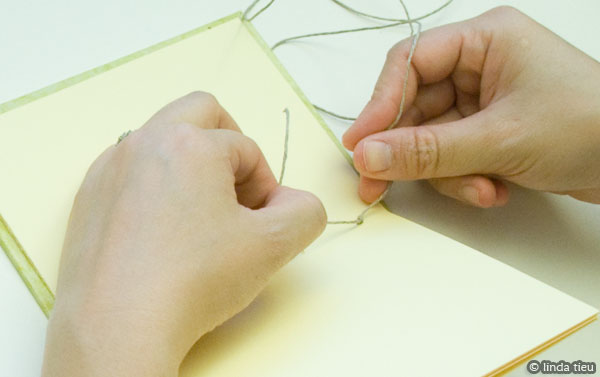
From this point, I just move up one hole and repeat the process of looping around the cover and coming back up. Only difference is that there is no knot to tie, you just keep looping through to attach the signature to the cover.
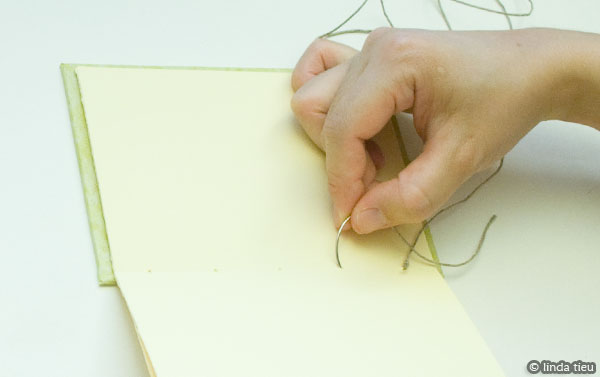
When you get to the last hole, after looping onto the cover, instead of going back into the same signature you stack on another signature and go into that hole.
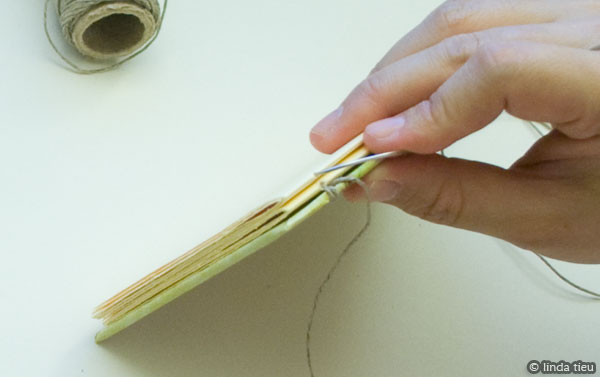
See how I’ve come up from the top hole in my second signature here…then I immediately go to the next hole…
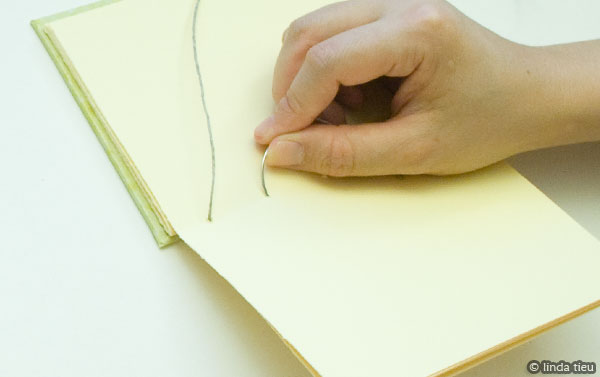
…and on the outside I want to attach this signature to something, but there are no holes to go through like with the cover. Instead I loop my thread in between the signatures below it, in this case the first signature and cover. Just stick your needle into the left side of the stitch already there and exit to the right of it.
This is a kettle stitch that connects the stitches together and creates the cool pattern on the binding. It is for this stitch that I use the curved needle, because it’s so much easier to stitch it in between the signatures when you have a curved needle to loop around.
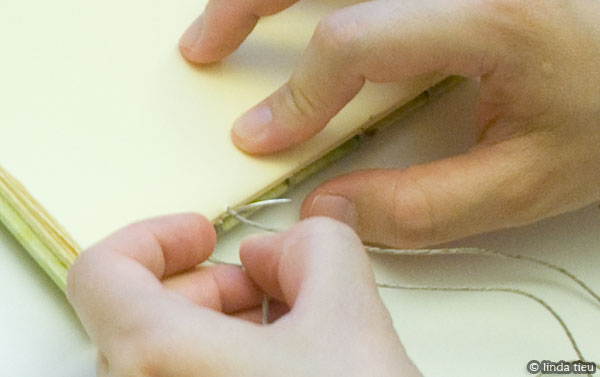
Here’s a close-up of the needle pulling the thread behind the existing stitch of previous signatures, from the left side to the right side. You are making a little loop to basically connect the new signature to the rest of the book.
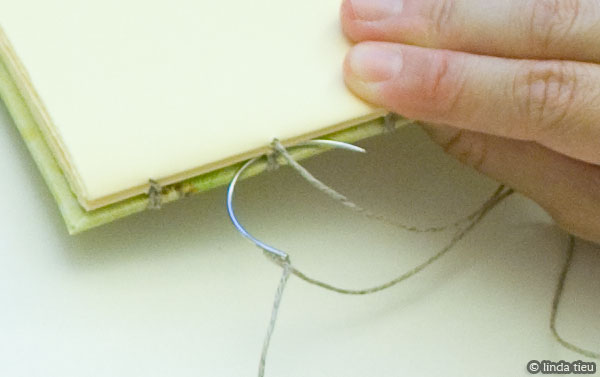
Once you’ve made this loop, the kettle stitch, and tightened the thread, you stick the needle back into the hole you came from and repeat going down the line of holes.
Remember when you are sewing the thread back into a hole you have already used, do not pierce through the thread that is already there. That would be cutting through your thread and making it weaker. Just put them next to each like friends!
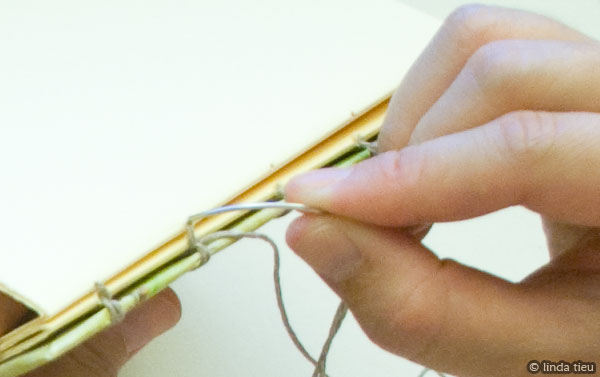
So repeat the process until you go through all the holes of this signature (basically connecting it to the stack you have… and when you get to the last hole, after doing the kettle stitch instead of going into that same hole again, you add another signature and go all the way up to that new signature bottom hole.
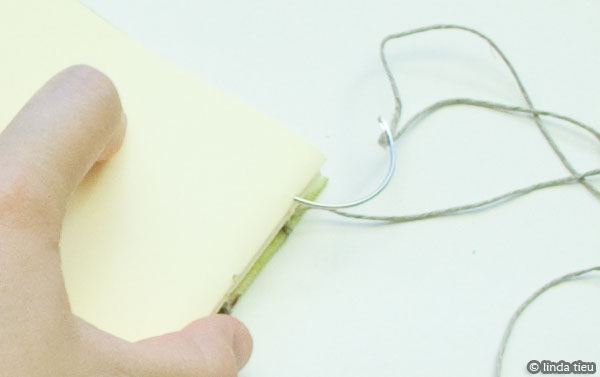
Then repeat the whole process, again and again until you attach all your paper signatures.
Once you get the idea, you’ll be able to continue for as many signatures as you have. You are basically attached your paper signatures one by one.
Now that I have added all 5 of my paper signatures, the final thing to do is to attach the cover.
I know there are ways of attached the final paper signature and cover at the same time, but I find it confusing, so my method is to just do the same thing with the final cover piece.
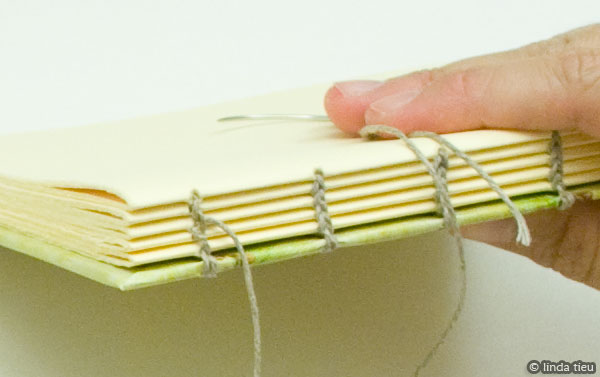
With just the cover left, I sort of do the same thing. But I weave through the last signature again, meaning it will have a double thread inside, but I don’t mind that at all for the ease of understanding this process.
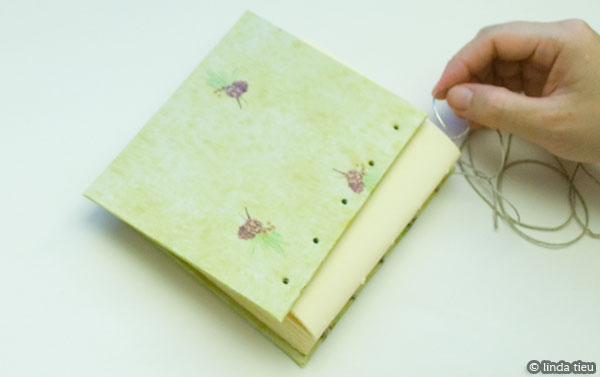
So going back to my last paper signature done and now having to add my cover. I do my double loop around the cover to match how I attached the front cover and do the kettle stitch to attach it securely to the book and then go back into the last signature of paper. I move up one hole and repeat the steps. It’s sort of doing the same thing, only attaching the cover back into the last paper signature.
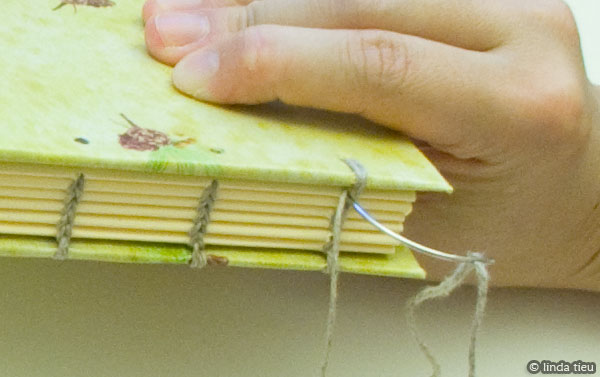
When I get to the last hole, instead of going back into the paper signature, I actually go in between the cover and paper signature.
I loop the thread around that stitch and tie a knot here to finish binding the book. One of these days I might learn another method that is cleaner, but this works nicely for me and the books I create are strong and don’t fall apart. So that’s good for me!
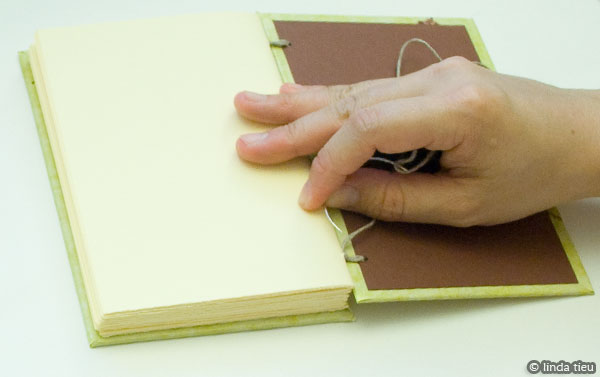
You’ll end up with a book that has a snazzy coptic stitch binding showing, very neat and secure. You’ll notice that the kettle stitches create a column of “v” or “u” looking pattern in the binding – which is very cool. The very left and right holes will look like half of that design, since it’s the edge.
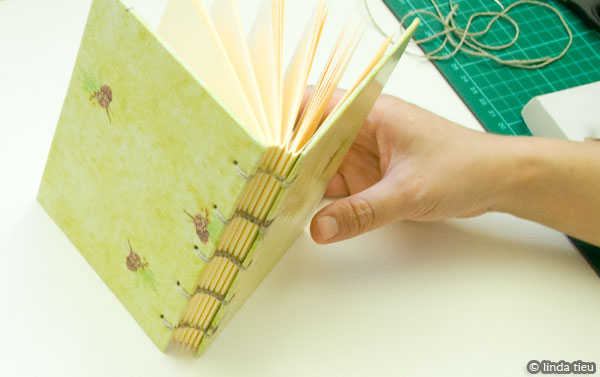
Now you can see how the book lies completely open when flat on a table… because of the way it is stitched together. That’s one of the big benefits of coptic stitch binding. You can see the entire page and most people find it great to write and work in because of this feature.
Of course, if you add too many paper signatures things may get imbalanced and unwieldy, so try it out a couple times, make a couple books and see what you like!
I hope this coptic stitch bookbinding tutorial was helpful – it’s my easy process of doing it with one needle!
I have also blogged about another chain stitched journal here and even though it looks cool, I’ve found it to be too fat. So that is the warning about giant books!
Too complicated still? You might want to try some other easy bookbinding tutorials I’ve written:
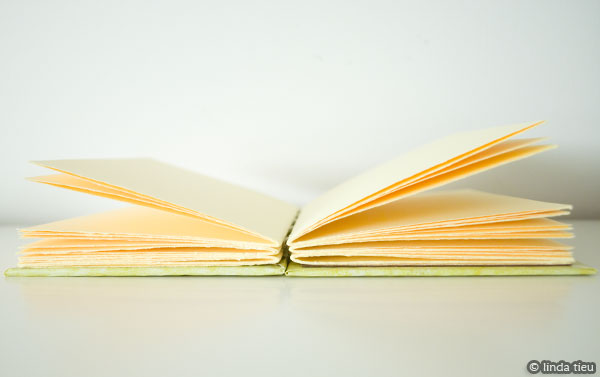
I like this kind of coptic stitch binding and find it cool, but I know it’s the easiest way ever. It does require precision and you want to make sure you tighten and keep things aligned as you sew the book up. Otherwise your signatures will be oddly hanging or crooked. I have even ended up tightening too much sometimes and the book doesn’t close completely because the thread is pulling on it… so beware!
You can of course, just put some paper weights on top of a finished book to even it out over time. The thread will stretch over time and use.
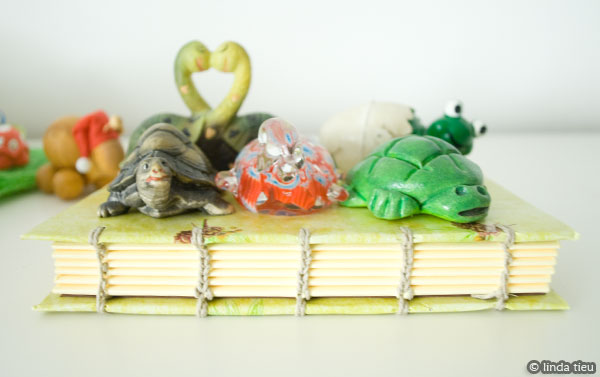
There are many other coptic and chain stitching tutorials out there, so don’t hesitate to find a youtube video that shows you the process in real-time or take a bookbinding course in person somewhere. It’s really the easiest way to learn, because you just have to dig in and try it for yourself!
DISCLAIMER: This post contains ads and affiliate links where applicable.
More Resources:
I wholeheartedly recommend CreativeBug (Get 3 months subscription for $1) because they have a coptic stitch tutorial as well and it’s very official by a professional bookbinder, so that is something to check out!
As with all things, once you try it a couple times, you’ll figure it out. So don’t hesitate! The results are satisfying for sure, so have fun!
Here are some bookbinding books on Amazon if you are looking to learn more:
